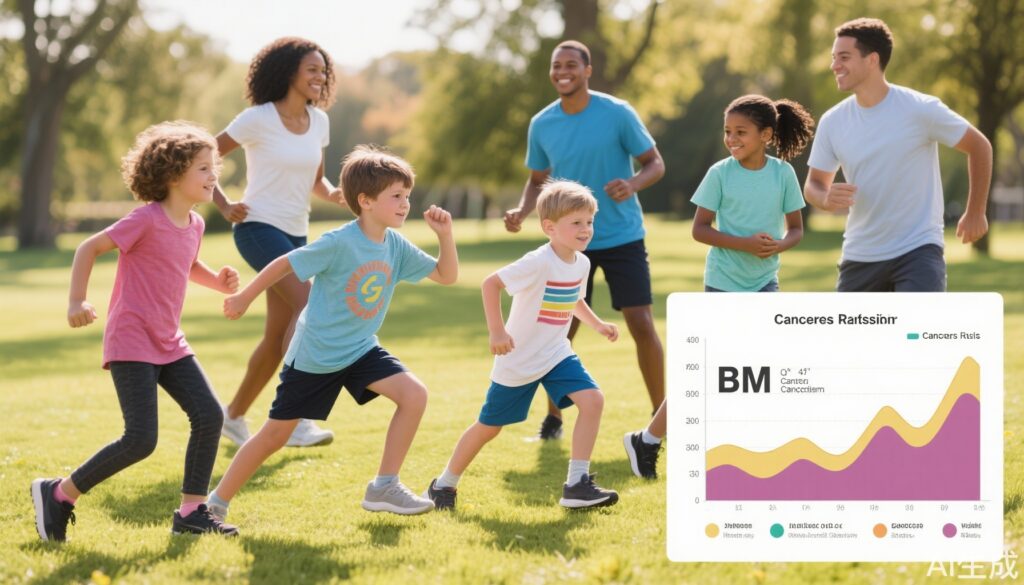Highlight
1. Obesity is independently associated with increased risk of solid organ, central nervous system (CNS), and skin subsequent neoplasms in childhood cancer survivors.
2. Higher physical activity levels correlate with a significantly reduced risk of developing subsequent neoplasms.
3. Combined lifestyle factors such as BMI and exercise may influence the development of specific subsequent neoplasm types like meningiomas and thyroid carcinomas.
4. Lifestyle interventions represent a promising avenue for secondary cancer prevention in this high-risk population.
Study Background and Disease Burden
Childhood cancer survivors face an elevated lifelong risk of developing subsequent neoplasms due to prior oncologic therapies and genetic predispositions. These subsequent malignancies contribute significantly to late morbidity and mortality. Modifiable lifestyle factors, including body mass index (BMI) and physical activity, have well-established associations with primary adult-onset cancers, but their role in subsequent neoplasm risk among childhood cancer survivors remains incompletely understood. Filling this knowledge gap is vital for developing preventative strategies tailored to this vulnerable population.
Study Design
This retrospective cohort study analyzed data from the Childhood Cancer Survivor Study (CCSS), encompassing 25,658 5-year survivors diagnosed before age 21 between 1970 and 1999. Participants were enrolled at pediatric tertiary care hospitals across the United States and Canada, with follow-up data through September 2019. Self-reported BMI and physical activity levels, measured in metabolic equivalent of task hours per week (MET-h/wk), were assessed at baseline upon cohort entry and up to six additional follow-up points before any subsequent neoplasm diagnosis.
The primary exposures were time-varying BMI and maximum physical activity prior to neoplasm development. Outcomes included incidence rates and cumulative incidence of any subsequent neoplasm, further subclassified into hematologic, solid organ, central nervous system (CNS), and skin cancers. Specific neoplasms analyzed included breast, thyroid, colorectal cancers, and meningioma. Relative rates (RRs) adjusted for demographic and clinical variables were estimated using piecewise exponential models.
Key Findings
Of 22,716 survivors with evaluable BMI data before neoplasm development (median attained age 33.7 years), 2,554 subsequent neoplasms occurred in 2,156 individuals. The median age at diagnosis of subsequent neoplasm was 37.4 years.
Physical Activity: Survivors with lower physical activity exhibited higher 30-year cumulative incidence of subsequent neoplasms — 18.6% for those reporting no activity (0 MET-h/wk) versus 10.9% for those engaging in 15–21 MET-h/wk. High physical activity was associated with a protective effect for any subsequent neoplasm (RR 0.61, 95% CI 0.53–0.71), and specifically for solid organ (RR 0.65), CNS (RR 0.50), and skin (RR 0.72) neoplasms.
Body Mass Index: Obesity correlated with increased relative rates for solid organ (RR 1.22), CNS (RR 1.47), and skin (RR 1.30) subsequent neoplasms. Notably, BMI and physical activity showed specific associations with meningiomas and thyroid carcinomas but were not linked to breast, colorectal, or hematologic subsequent cancers.
This study underscores that adverse lifestyle factors contribute significantly to the burden of subsequent neoplasms in childhood cancer survivors. The data advocate for integrating BMI management and exercise promotion into survivorship care.
Expert Commentary
These findings provide critical epidemiologic evidence that lifestyle factors modulate secondary cancer risk in childhood cancer survivors, consistent with biological mechanisms linking adiposity and cancer through chronic inflammation, hormonal dysregulation, and immune modulation. Physical activity likely exerts its protective effect via improved metabolic health, immune function, and reduction of adiposity. However, causality cannot be definitively established due to observational design. Self-reported BMI and physical activity may introduce reporting bias. Residual confounding by treatment exposures or genetic susceptibility remains possible.
Nevertheless, clinical guidelines increasingly emphasize comprehensive survivorship care incorporating lifestyle counseling. Future randomized interventions are warranted to test whether targeted lifestyle modification prevents subsequent neoplasms and improves overall health outcomes in this high-risk group.
Conclusion
This large cohort study demonstrates that obesity augments while higher physical activity attenuates subsequent neoplasm risk among childhood cancer survivors. These results highlight an actionable opportunity to incorporate lifestyle interventions into cancer survivorship programs to help mitigate long-term morbidity. As systemic treatments for childhood cancers improve survival rates, addressing modifiable risk factors will be paramount to optimize health outcomes. Further research is needed to develop effective behavioral interventions and delineate mechanistic pathways linking BMI and physical activity with tumor biology in this unique population.
References
1. Joffe L, Mirzaei S, Bhatia S, et al. Body Mass Index, Physical Activity, and Subsequent Neoplasm Risk Among Childhood Cancer Survivors. JAMA Oncol. 2025;11(8):835-845. doi:10.1001/jamaoncol.2025.1340.
2. Armstrong GT, Liu Q, Yasui Y, et al. Long-Term Outcomes Among Adult Survivors of Childhood Central Nervous System Malignancies in the Childhood Cancer Survivor Study. J Natl Cancer Inst. 2009;101(13):946-958.
3. Ligibel JA, Alfano CM. Physical Activity and Cancer Survivorship. In: DeVita VT Jr, Lawrence TS, Rosenberg SA, editors. Cancer: Principles & Practice of Oncology. 11th ed. Philadelphia, PA: Wolters Kluwer; 2019.


